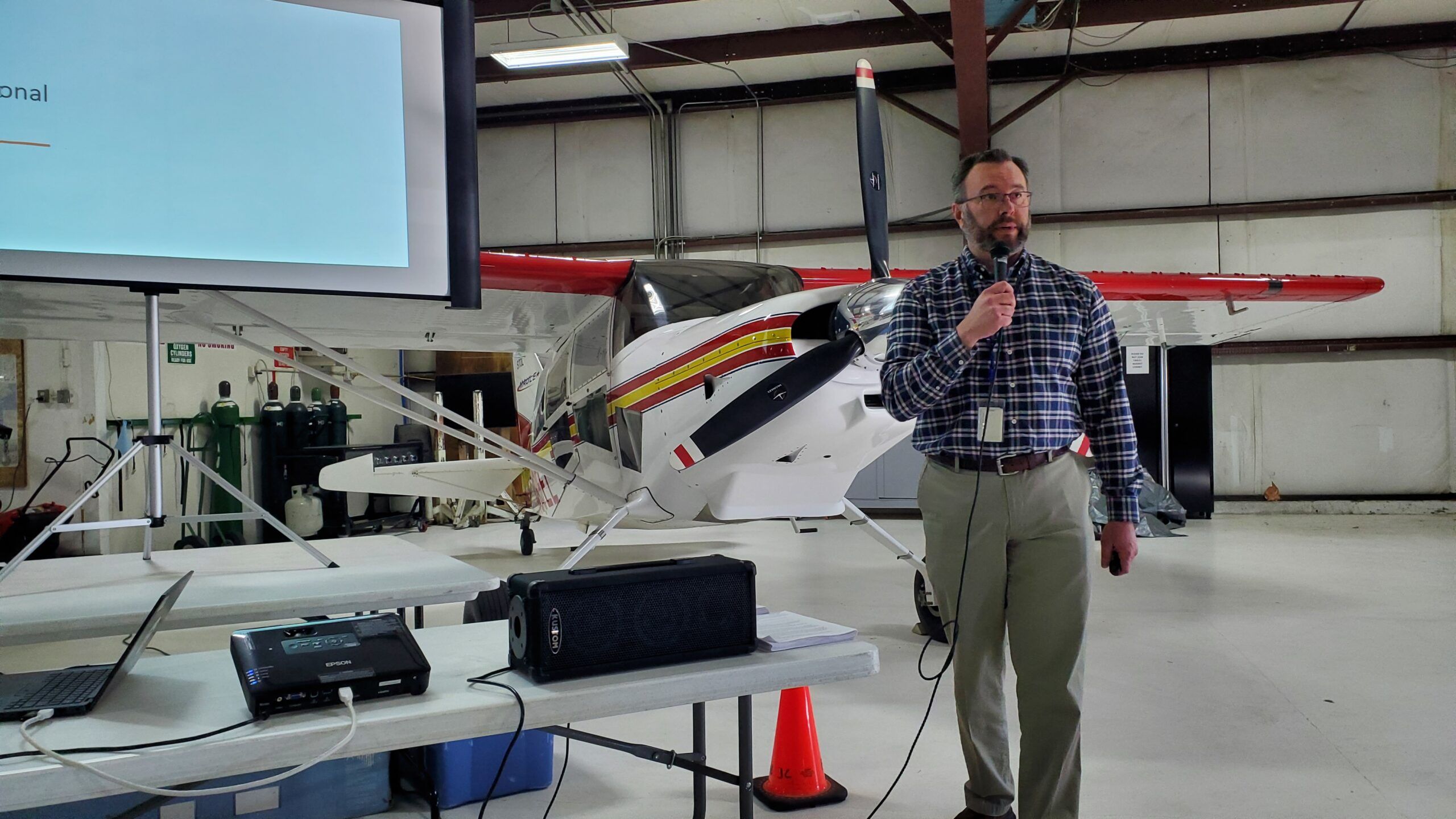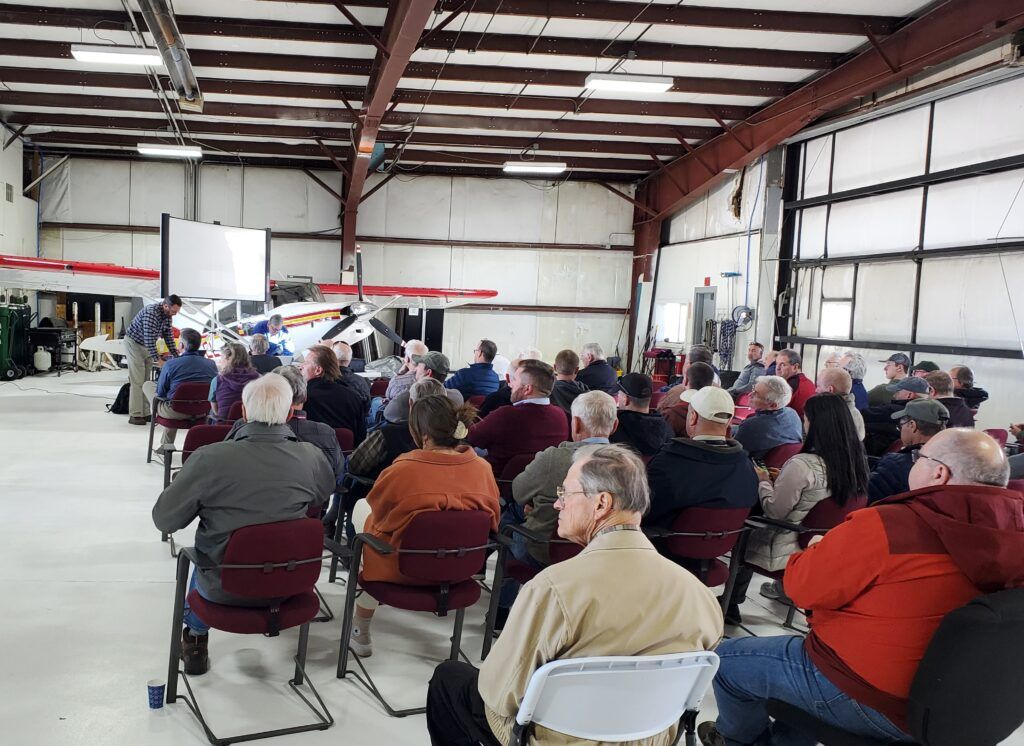Northern Colorado airport plane owners search for alternatives to eviction

LOVELAND — The governing commission of Northern Colorado Regional Airport may hear some proposals next week for ways to give owners of general-aviation aircraft more time to find ways to keep their planes sheltered instead of being evicted this spring and summer.
Richard “Rick” Turley, acting simply as a self-described “annoyed hangar resident” and not as a member of the FNL Pilots Association, told a crowded town hall meeting Thursday at the airport’s jetCenter hangar that he wanted to present alternative ideas to the commission at its next meeting. That panel, at a special meeting March 2 that was called with three days’ notice, cited safety and liability concerns in ruling that four airport-owned hangars would be decommissioned, displacing 47 aircraft.
“My desire is to buy time,” Turley said. “How can we remain with aircraft in these hangars beyond the stated eviction date and get approval to stay in them while we move the process forward.
SPONSORED CONTENT
Federal District Court Rules Corporate Transparency Act Unconstitutional . . . But Most Small Businesses Must Still Comply
Lyons Gaddis Real Estate and Business Attorney Cameron Grant shares important details of the Corporate Transparency Act (CTA).
“What I would like to do is go in next Thursday with the outline of a proposal and see if we can garner support,” Turley told the audience, which he estimated from a show of hands was made up about 85% of people who currently shelter planes in hangars on the airport’s grounds.
Turley said his goal was threefold: “How do we mitigate the risk to safety and liability, which is all we’ve been told; Develop a transition plan to somehow get from those hangars to something in the future; and find long-term solutions — how do we get viable t-hangar space built in a timely manner on this airport.”
Airport director Jason Licon had opened the meeting with his explanation of why the decision was made, but was pelted with sometimes-angry comments from the owners, prompting Turley to thank Licon “for doing this without a flak suit.”

Like many in the audience, Turley said, “I was very frustrated by this. I did not see it coming.”
However, he said, he’s compiling a list of affected pilots’ emails and wants to turn it into something positive.
“The commission said they were open to input and proposals from affected pilots so long as we addressed the safety and liability concerns that had been raised in the previous engineering report,” Turley said. “What they also said was that we could bring forth proposals at upcoming commission meetings.”
The commission’s next regular meetings are March 16 and April 20, both scheduled before the May 10 and July 11 deadlines the owners had been given to move their planes out of the four condemned structures.
Turley said he asked commission members, “Am I wasting my time and energy here? Is this a foregone conclusion, or are you open to proposals? The answer I seemed to be getting was yes, it’s open. They really do want to solve this problem. They are frustrated as well that, based on the risk-management departments of both cities” — Loveland and Fort Collins, the joint owners of the airport — “they’ve been advised to not allow those hangars to continue to be used.”
The airport offered the displaced pilots outdoor tie-downs for their planes, but most of the owners found that option unacceptable because of the potential damaging effects on their craft from sun, wind and hail.
“I’ve had a plane parked in these hangars since 2011,” Turley said. “It’s a Cessna 182, built in 1976 but it flies great, but it will weather quickly if I have to leave it outdoors. I need another option than keeping the plane outdoors.”
Licon opened the meeting by noting that the airport master plan, drafted in 2007 and updated in 2009, had indicated that the area including the four condemned hangars would be targeted for redevelopment.
According to a page on the airport’s website that is devoted to explaining the hangar issue, “In 2021, an unsolicited proposal was received from the Airport’s fixed base operator (FBO), jetCenters of Colorado, to redevelop the hangar area. This proposal was provided knowing that the area was targeted for redevelopment, and that the cities now own all of the hangar units. Upon review by the Airport Commission, it was determined that the area needed to go through a formal advertised request for proposals (RFP) process from interested parties. The RFP was advertised in late 2021 and generated three responses. An evaluation committee reviewed the proposals, collected additional information, engaged in negotiations, and made recommendations to the Airport Commission. Ultimately, the Airport Commission voted to close the RFP without award.”
The jetCenter bid created similar pushback in summer 2021 because it would have displaced dozens of private aircraft owners. The lease agreement with Fort Collins-Loveland jetCenter would have razed three T-hangars that house about 60 private planes and permitted jetCenter to build jet hangars and jet services on that land. The owners complained about the lack of notice of the lease agreement, that their interests were not taken into consideration since private hangar space is in short supply along the Front Range, and they asked why the jetCenter proposal, an unsolicited bid, wasn’t opened up to competitive bids.
The airport then commissioned Fort Collins-based Ditesco Project and Construction Services “to identify the useful lifespan of these hangars for planning purposes,” Licon said. “Unfortunately, to our surprise, the conclusion of those analyses were that the structures were observed to have significant issues, to the point where we thought a couple of these buildings had this amount of structural failure, but not all of them. And as part of the investigation, it was identified that all of the hangars had certain defects that would not be able to be retrofitted to adhere to current building standards or codes or be able to meet the service-life extension that we were seeking to create.”
Owners wondered why an emergency meeting was called, complete with an executive session, when the engineers’ report was dated Sept. 20. Licon responded that after hearing from Loveland’s and Fort Collins’ risk-management and legal departments, “we did further investigation, and a report came back in February.”
A Feb. 5 letter from engineer Jill Burrell at Ditesco identified “concrete structural foundation failure, column to foundation anchorage failure, untreated subgrade, missing or damaged hardware, misplaced structural column load bearing, deformed structural members and failed tension rod connections.
“With the structural conditions witnessed during the initial field inspection,” Burrell wrote, “it is highly anticipated that similar conditions exist throughout the remaining structure.” She termed the four hangars “not salvageable and not a candidate for retrofit.”
The ruling to decommission the hangars was made, Licon said, after discussing the addendum with the cities’ risk-management and legal teams.
Pilots at the meeting charged that “safety” wasn’t part of the engineers’ report, but in a March 7 letter from Ditesco, five days after the closure was announced, engineer Keith Meyer wrote that, “while we noted occupancy risk in our report, we were not contracted to, nor did we perform, failure analysis of those structures. Throughout the process, our staff have been asked if the hangars are ‘safe.’ As practicing professional engineers, our greatest obligation is to hold paramount the safety, health and welfare of the public. We feel continued use of the hangars presents risk to the occupants and FNL.”
A second opinion, Meyer wrote, is “outside of our contracted scope of work.”
Turley advocated that second opinion.
“The engineering report that was created was not intended to determine whether or not these hangars are safe, and wasn’t intended to address liability issues,” he said. “One of the first steps is getting an engineering report that’s more thorough, that wasn’t just a spot check. We have a different set of objectives for this second opinion than the set of objectives the engineering firm was given in the first place.
“We need to look at liability. How is it that we can absolve the cities of what they perceive to be the liability they have with the airport?” One way, Turley said, would be “forming a hangar association that maintains the insurance on the structures and maintains liability for the structures, and to a certain extent absolves the cities of that liability.”
Addressing possible next steps, Licon said, “obviously part of that would be to begin work on trying to develop a new hangar site. That’s not going to do any good for anybody that’s going to be displaced right now. We understand that. That’s the unfortunate circumstance that we’re in given the structural analysis and the cities’ need to move people out for the concerns that we’ve identified.
“We do want to do whatever we can to make this as soft a landing as possible for everybody who’s being impacted,” he said.
The four targeted hangars were built between 1965 and 1977 and contain 57 usable hangar units with 64,500 square feet of storage space and are leased on a month-to-month basis to owners of small aircraft.
Licon said the “cities have always relied on the private sector” to build T-hangars, but Martin Lind, who heads Water Valley Land Co., had negotiated to bring a U.S. Customs facility to FNL and owns Discovery Air Center at the airport, responded that “we proposed 120 new hangars, which was rejected, and we never even got an answer back. There’s something wrong at this airport, and it’s up to you guys to go find it. This is wrong, Jason.”
Lind said proposals from him, jetCenter’s and a pilots’ group were the three responses the airport commission got to its 2021 request for proposals.
“I’m super unhappy about this because you guys deserve to stay here,” Lind told the assembled aircraft owners. “You guys deserve a fighting chance to keep your airplanes indoors, and you deserve a lot longer notice of this.”
Lind released a 20-minute video in which he detailed his experience, including what he received when he filed a Colorado Open Records Act request to see what the other two proposals contained so that he could use that information to modify his own application. He displayed the reports he got back, but they included multiple pages that were solid black with redactions.
“I want an unredacted look at those reports.” he told Licon.
In a conversation after the town hall, Licon pleaded with Lind, “Let’s reboot” and find a solution.
That solution is a necessity for the owners, Turley said, because, “at the moment, if we do nothing, we’re all out.”
LOVELAND — The governing commission of Northern Colorado Regional Airport may hear some proposals next week for ways to give owners of general-aviation aircraft more time to find ways to keep their planes sheltered instead of being evicted this spring and summer.
Richard “Rick” Turley, acting simply as a self-described “annoyed hangar resident” and not as a member of the FNL Pilots Association, told a crowded town hall meeting Thursday at the airport’s jetCenter hangar that he wanted to present alternative ideas to the commission at its next meeting. That panel, at a special meeting March 2 that was called with…
THIS ARTICLE IS FOR SUBSCRIBERS ONLY
Continue reading for less than $3 per week!
Get a month of award-winning local business news, trends and insights
Access award-winning content today!


